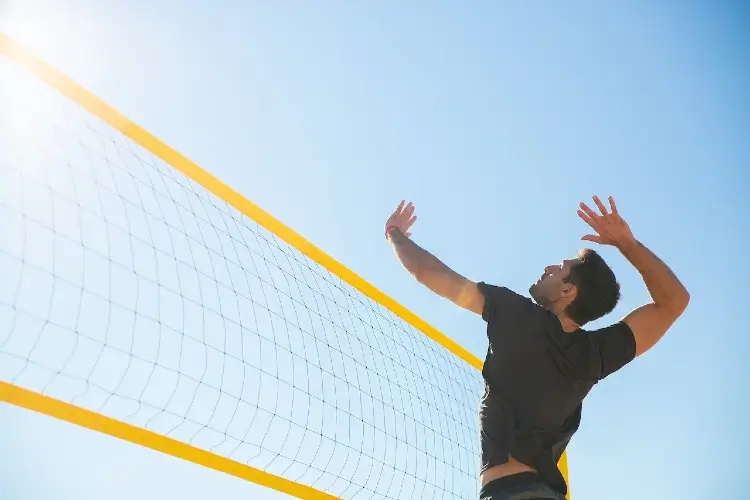Last Updated: January 12, 2024
A volleyball spike is performed by moving the arm in such a way that the ball lands uncontested on the opponent’s side of the court. Basically, the front-row player will jump up and strike the volleyball with all his might to score a point.
For the ball to take off like a missile, the strike should have a lot of power and precision behind it. After all, a slow and graceful spike won’t be effective on the court because the opposing team will have no trouble blocking it.
In a nutshell, a volleyball spike needs to be fast and explosive to take the opponent by surprise. You also need a lot of precision behind the strike to make it effective. After all, you won’t earn a point for your team if you strike the ball right into a blocker. No matter how explosive the spike is, it will be of no good if it’s getting blocked easily by the defenders.

The spiking technique goes a long way in putting the rivals to shame. A spiker typically needs to take a series of steps to strike the ball well enough to improve their chances of scoring.
From precise foot movement to body conditioning, a lot goes behind a powerful and effective spike. So, let’s unlock the science behind a powerful and effective attack.
Spike Harder by Nailing the Technique
Get the angle right
To begin with, you need to practice striking the ball at a sharp downward angle with a lot of topspin. The steep downward angle will make it challenging for the opponent to react quickly to defend the spike. Better still, the topspin will cause a faster descent.
Aim to strike the ball at the highest point of your jump while snapping your wrist and fingers downward. The wrist snap should be initiated at the point of contact with the ball. This synchronized action will allow you to direct the ball at a steep angle while imparting spin.
Swing the arms faster
To increase the power behind the spike, players make it their mission to hit the ball as hard as possible. If you have tried working with a good coach, he will tell you to stop such hard-hit spikes. Instead, you will be suggested to focus on swinging your arms faster.
When players go for hard hits, they tighten their upper body, which prevents them from unleashing full power. A fast swing generates more force, making the spike far more effective than a hard-hit spike. The challenge is to swing fast and be accurate as well, which takes a lot of practice.
Jump right
To connect with the ball using maximum force, it needs to be in front of your shoulder. If your shoulder is not behind the ball, you will lose out on a lot of force production, leading to a lackluster volleyball attack.
As you approach to connect the ball, you need to explode off the court with maximum jumping force while swinging both your arms to maintain the jumping momentum. After hitting the ball, you should prepare to land safely by maintaining a small bend on the knees during the descend. This will minimize the impact from the ground.
Get the timing right
A powerful spike requires perfect ball timing skills. Unless you time your spike well, it won’t travel fast over the net, making it easy for your opponents to defend your spike. Errors in timing can also impact your ability to aim for open areas on the court.
To get your spike timing right, you should align your footwork with the ball’s path and the setter’s action. During practice sessions, it helps to work with a setter who can set the ball high enough for you to practice spiking at the top of your jump.
Don’t miss the follow-through
The follow-through lets you capitalize on the energy generated from the jump into the ball, resulting in a powerful spike. So, the way you finish the follow-through matters a lot. It lets you send the ball to the other side of the net at full speed without touching the net.
This is one of the key spiking mistakes players often make. After striking the ball, you should continue your arm’s motion in the direction of the intended target. Many players bend their elbows after hitting the ball, which should be avoided. The arms should remain fully extended as you continue the follow-through movement.
Spike Harder by Getting Fast and Strong
Get quick on your feet
If you are not quick on your feet, you won’t be able to connect with the ball at the right moment with the best possible angle of attack. Therefore, you need to approach the ball with good speed to spike the ball with both power and precision.
If you lack speed, include sprinting sessions in your training routine. You can also do footwork drills to improve your lateral movement. Even if you get slightly faster than before, you will excel at spiking because split-second decisions matter a lot in a fast-paced game like volleyball.
Get a stronger body
Start strength training to get a stronger body. With a strong upper body, you will be able to pack a lot of power behind your spike. That said, train your lower body as well because a significant portion of your spike power will come from the vertical jump alone.
Recommended read: Spiking Finesse vs. Power: Finding Your Unique Style for Devastating Attacks
When approaching the net, you will push off by generating force from your legs, enabling you to jump powerfully in the air. Exercises like push-ups, bench press, leg press, and rows can be incorporated into your strength training regime to build strong muscles.
Improve your jumping ability
With any attacking strategy, you need to hit the ball from a good height to get it effectively over or around the blockers. In other words, you should aim to connect with the ball at a higher height to enhance your spiking ability. To achieve this, you need to include exercises and drills that improve your vertical jumping ability.
You can use a vertical spike trainer to practice jumping as high as possible. This device features a pole system that often comes with height adjustability and a ball attachment on the top. The device lets players work on their jumping abilities, timing, and hitting accuracy.
Do flexibility and mobility exercises
As a volleyball player, you must prioritize flexibility and mobility exercises. Adequate flexibility and mobility will help you perform various volleyball shot variations without getting injured. A sport like volleyball requires fast-paced movement adjustments, often increasing the risk of injury.
Adequate flexibility and mobility will reduce the occurrence of sprains, tears, and cramps, allowing you to keep playing volleyball without any fuss. Exercises of this nature will also provide you with an optimum range of motion, essential for generating power to execute explosive attacks.
Hip circles, arm circles, hip flexor stretching, leg swings, and arm swings are some examples of flexibility and mobility exercises that can maximize your range of motion. Additionally, you also need to do static stretching after your workout and practice sessions. As for the mobility exercises, you can do them as often as you can in a week.
Spike Harder through Volleyball Drills
Practice hitting targets
Incorporating target-based spiking drills can enhance the accuracy of your volleyball spike to a great degree. Look for targets in the court where you want to direct the ball. Aim for areas that the opponents will have trouble reaching, like deep zones, corners, and your opponent’s weak spots.
You can use cones or hula hoops to provide reference for your targets. Alternatively, you can mark the area where you want to direct your spikes with chalk. Practice by standing on a tall box, around the same height you would be when jumping to perform a strike. Have a teammate set the ball to you so that you can practice your spike.
Medicine ball drills
For power development, you can incorporate overhead medicine ball drills in your training regime. Overhead medicine ball throw is a great way to build explosive strength. You will practice by throwing the ball upwards against a sturdy wall while jumping off the ground. You should aim to throw the ball as high as you can and catch it on its way down.
So, focus on both speed and power. You can perform this exercise for a pre-determined number of repetitions or a set time. As for the medicine ball’s weight, you can choose it based on your strength level. A medicine ball weighing anywhere between 6-12 pounds should work well for this drill.
Conclusion
Skill learning is important in any sport, including volleyball. It’s an ongoing process, though. No one can go from being an average to a top-class volleyball player at the drop of a hat.
Regardless of how dedicated you are, improvements are going to take time. You should not feel bad about it and know it will be worth the effort in the end.
